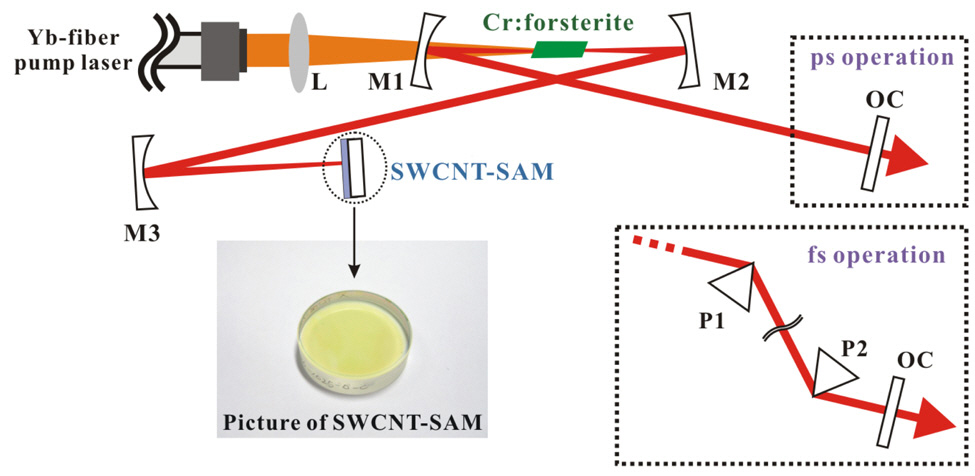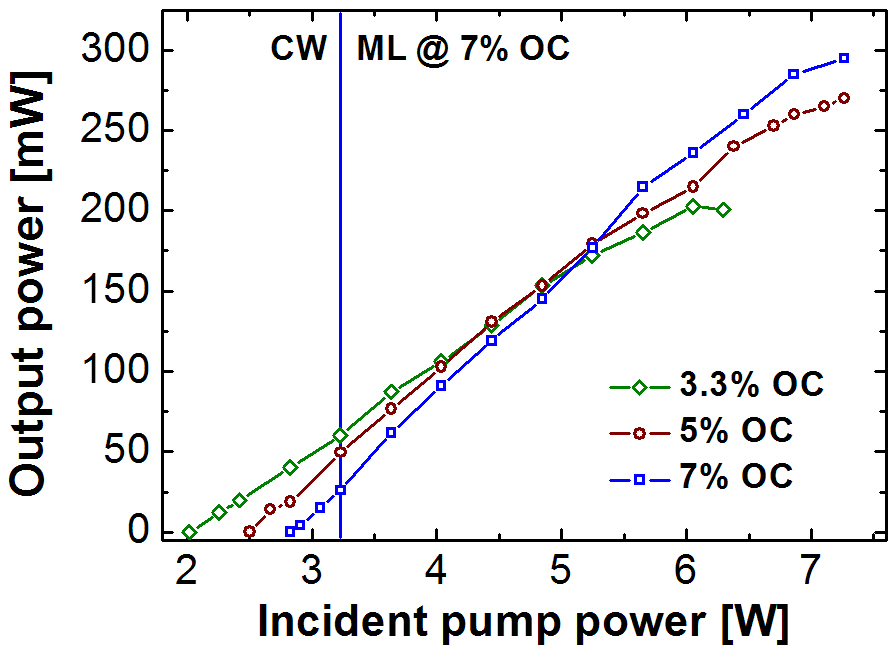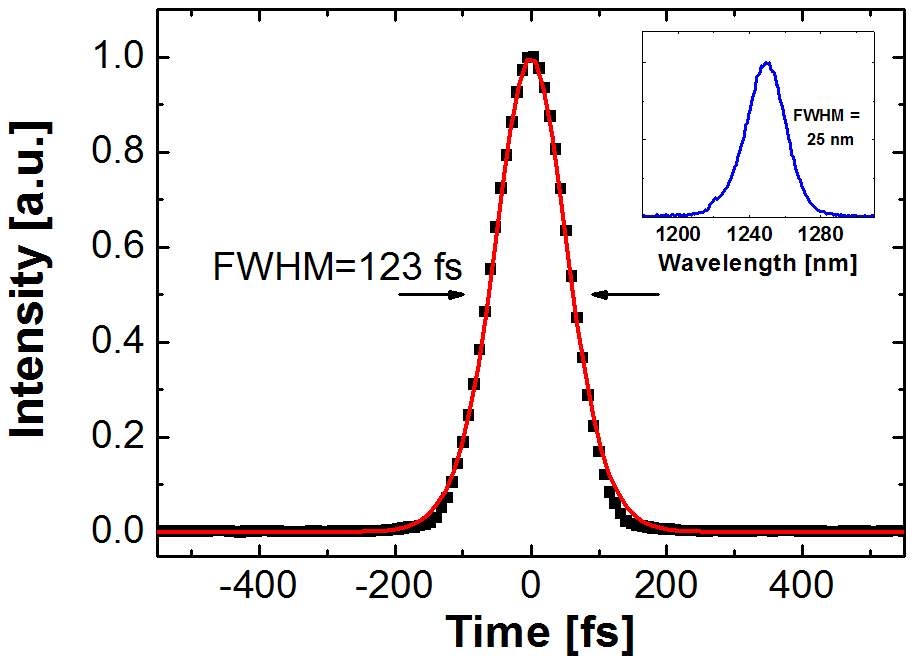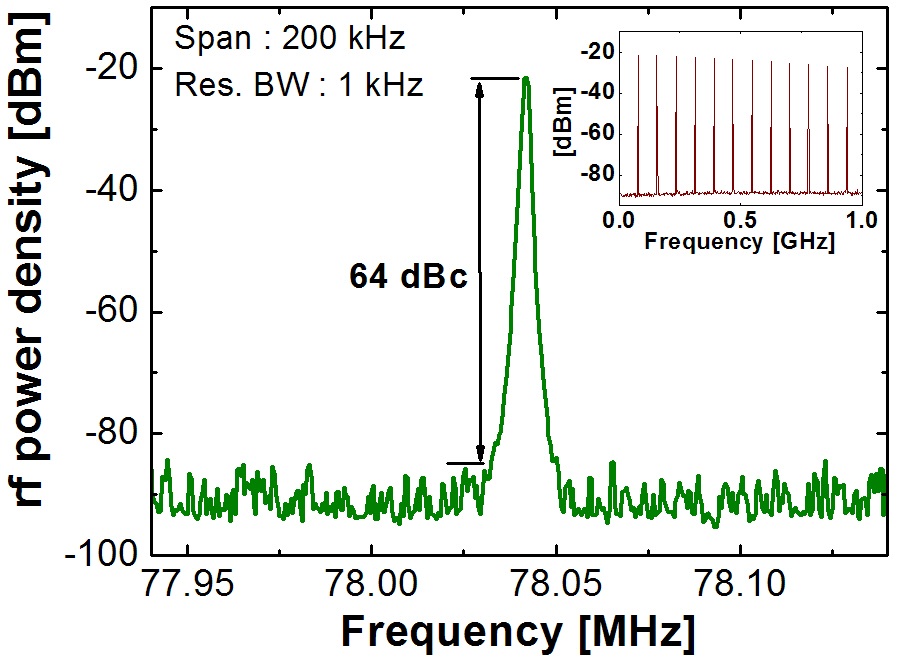



Passive mode-locking is a well-known method to generate ultrashort pulses. Although Kerr lens mode-locking (KLM) is a widely used technique for passive mode-locking without saturable absorbers in solid-state lasers, this scheme generally requires critical cavity alignment and, moreover, self-starting operation is often not achieved in KLM lasers. Hence, saturable absorbers (SAs) such as semiconductor saturable absorber mirrors (SESAMs) have been extensively used for reliable and self-starting laser operation [1, 2]. While SESAMs are superior to other kinds of saturable absorbers such as organic dyes, Cr4+-doped crystals, and dye-doped solids in term of their durability, controllability of linear and nonlinear optical characteristics and operational spectral ranges, they have several limitations. SESAMs are fabricated by expensive and complex manufacturing processes such as molecular beam epitaxy (MBE) or metal-organic chemicalvapor-phase deposition (MOCVD), and low-temperature growth or an additional post-treatments of ion implantation is often required to reduce the response time of devices [1,3]. In addition, SESAMs for broadband applications must reach a compromise between their bandwidth and the insertion loss mostly induced from the lattice mismatch between the absorbing layer and the Bragg reflector. Otherwise, special broadband SESAMs containing metallic mirrors are often used, but such SESAMs also suffer high loss induced from morphology of the metal-semiconductor boundary [4].
Recent reports announcing ultrafast saturable absorption in single-walled carbon nanotubes (SWCNTs) motivated development of a ultrafast passive mode-locker based on SWCNTs [5, 6]. After the first demonstration of SWCNTSA mode-locking in a fiber laser that can tolerate large insertion losses [7], SWCNT-SAs also have been successfully applied to passively mode-locked bulk solid-state lasers,such as Yb3+-, Cr4+-, and Tm3+-doped lasers, with reduced non-saturable losses in the spectral range between 1 and 2㎛ [8-13]. Low-cost and relatively easy fabrication of such novel saturable absorbers with ultrafast recovery time and quite high damage thresholds show high competitiveness compared to former passive devices including SESAMs. Moreover, the operation spectral region of SWCNT-SAs can be easily controlled without bandwidth limitation by choosing SWCNTs with the appropriate diameter and chirality, whereas it is obviously not the case in SESAMs containing a Bragg reflector.
Recently, we reported the first mode-locking of a Cr:forsterite laser with a transmitting SWCNT-SA delivering transform limited pulses as long as 120 fs. The laser yielded maximum average output power of about 200 mW [10]. Although the output power was quite high for SWCNT-SA mode-locked solid-state lasers, a quartz substrate for transmitting SWCNTSA and two additional concave mirrors lead to additional intracavity losses.
In this paper, we report on passive mode-locking of the Cr:forsterite laser using a SWCNT SA mirror (SWCNT-SAM), i. e. a SWCNT-coated dielectric mirror. The SWCNT-SAM fabricated in the present work enabled self-mode-locked Cr:forsterite laser delivering 80 fs pulses with output powers up to 295 mW near 1.25 ㎛.
II. FABRICATION AND CHARACTERIZATIONS OF SWCNT-SAM
For manufacturing SWCNT-SA mirrors (SWCNT-SAMs), HiPCO SWCNTs (Unidym) were used as the fundamental element. Sufficiently dried SWCNTs were dispersed in dichlorobenzene (DCB) and then mixed with a separately prepared polymethyl methacrylate (PMMA) solution. The detailed process of SWCNT/PMMA composite preparation was described in Ref. 10. Finally, SWCNT/PMMA composite was spin-coated on a broadband high-reflection (HR) dielectric mirror centered at 1.25 ㎛. The typical thickness of the SWCNT absorbing layer was estimated to be about 250 nm. The film thickness can be controlled either by the concentration of the SWCNT/PMMA mixture or by the rotation speed of the spin coater. Linear transmission of the HiPCO SWCNT absorbing layer on the HR mirror shows an ultrabroad absorption band covering more than 500 nm around 1.3 ㎛. The nonlinear optical response of SWCNT-SAM was studied near the laser operation wavelength around 1.3 ㎛ by time-resolved pump-probe spectroscopic measurements. The measured pump-probe trace shows biexponential response with a 1/e recovery time of about 2 ps accompanied by a weak instantaneous response in the time scale of < 200 fs. The fast and slow decay correspond to the interband and intraband E11 transition of semiconducting SWCNTs. Other important parameters for passive mode-locking such as modulation depth (ΔR = 0.37%) and saturation fluence (Fsat = 6.0 μJ/cm2) were also investigated by nonlinear reflection measurements. These optical characteristics of SWCNT-SAM compare favourably with those of previously reported SESAMs for ultrafast mode-locking [14, 15].
III. PASSIVELY MODE-LOCKED CR:FORSTERITE LASER
For experimental verification of passive mode-locking of bulk lasers using SWCNT-SAM, we modified a home-made Cr:forsterite laser [10]. The layout of the Cr:forsterite laser comprising the SWCNT-SAM is shown in Fig. 1. The diodepumped continuous-wave (cw) Yb:fiber laser (PYL-10-LP, IPG Photonics) delivering up to 10 W at 1064 nm was employed as pump source and the pump beam was focused by a convex lens of focal length 10 cm on the laser crystal. A 11-mm-long, 3-mm diameter, Brewster-cut Cr:forsterite crystal was used as the gain medium and possesses a smallsignal absorption coefficient of
Without GDD compensation, we observed passively modelocked self-starting operation in the ps regime. The Cr:forsterite laser produced strongly chirped pulses as short as 11.7 ps with a spectral bandwidth of 5.5 nm at the wavelength of 1236 nm. In the picosecond regime the maximum average output power of 290 mW were measured at a repetition rate of 86.4 MHz with a 3.3% output coupler (OC). Once the laser was mode-locked, the SWCNT-SAM could be moved perpendicular to the beam path by about 15 mm
without disturbing the mode-locked operation. This stable mode-locking is clear evidence for homogeneous distribution of SWCNTs on the mirror. To achieve femtosecond pulses, we employed two Brewster-cut SF10 prisms in the resonator. Three output couplers (OCs) with different transmission were used to optimize the average output power as well as the stable operation. Figure 2 shows the measured output powers as a function of the incident pump powers. In the mode-locked operation the laser delivered average output powers up to 203, 270 and 295 mW with 3.3, 5 and 7% OC, respectively, without onset of multiple pulsing and cw components. Even though higher output powers of > 300 mW with 7% OC could be achieved through additional increment of the pump power, the competing cw component and multiple pulse mode-locking could not be easily suppressed. The intracavity pulse energy required for stable mode-locking was calculated from the relation EP > (Esat, L Esat, A ΔR)1/2, where Esat, L = Fsat,LAeff,L and Esat, A = Fsat,AAeff,A are saturation energy of the gain medium and the absorber, respectively. Esat,X defined by the product of saturation fluence (Fsat,X) and effective laser mode area (Aeff,X) on each component, whereas X = L for the gain medium and X = A for the saturable absorber [16]. From the analysis, the pulse energy EP on the SAM in the cavity indicates about 5.8 nJ, resulting in average output power of 33 mW at 7% output coupling. Although small perturbations produced by translating prisms or tipping the SWCNT-SAM were required to initiate the mode-locked operation near the ML thresholds, the measured output power at the mode-locking threshold was approximately 27 mW for 7% OC. This measured value agreed well with the theoretical expectation. In the power range from the ML threshold to the maximum, the incident pump fluence on the SWCNT-SAM was 0.05-0.54 mJ/cm2, sufficient for saturating the absorber.
After stable self-starting operation for hours, especially
at high pump powers, small perturbation was required to initiate laser mode-locking. Such performance variation was caused by slight degradation of nonlinearity of the SWCNTSAM for high incident energy fluence, which however turned out to be reversible. Compared with the transmitting SWCNT-SA where the laser beam size on the device could be varied by moving its position to the out-of-focus regime resulting in reduced energy fluence on the transmitting SA [10], the reflecting device has to be located near the focus for stable operation. Although this reversible process was not clearly identified yet, reactions between SWCNTs and oxygen and thermal loads at the boundaries [8] might be the reason. This phenomenon was fully suppressed by purging the SWCNT-SAM with dry N2.
The reported group velocity dispersion (GVD) and thirdorder dispersion (TOD) of the Cr:forsterite crystal amounted to ~20 fs2/mm and ~57 fs3/mm in the 1.25 ㎛ spectral range, respectively [17]. According to the measured values, each round-trip GDD and TOD of the gain medium, are 440 fs2 and 1254 fs3. With tip-to-tip separation of 36 cm the prism pair delivered the refractive GDD and TOD of -2612 fs2 and -2381 fs3, which were enough to achieve slightly negative net intracavity GDD for stable mode-locking. After optimization of the oscillator, self-starting femtosecond pulses at a repetition rate of 78 MHz were generated. The modelocked laser was running stably in a mode-locked operation for hours. To verify the pulse duration we used the typical background-free intensity autocorrelator with a 0.1-mm-thick □-barium borate (BBO). As shown in Fig. 3, assuming a sech2-pulse shape, the generated pulses were as short as 80 fs with a spectral bandwidth (FWHM) of 25 nm at central wavelength of 1.25 ㎛ (inset of Fig. 3). The time-bandwidth product was 0.384, close to the Fourier-transform limit. We also recorded the radio frequency (RF) spectra of the SWCNT-SAM mode-locked Cr:forsterite laser. A sharp RF peak in Fig. 4 at the fundamental beat note of 78.04 MHz,
measured with a resolution bandwidth of 1 kHz within a 200-kHz span, shows an extinction ratio of 64 dB relative to carrier (dBc). This high signal-to-noise ratio and the wide-span measurement up to 1 GHz (inset of Fig. 4) clearly indicate a stable single-pulse mode-locking without multiple pulsing and Q-switching instabilities.
In conclusion, we fabricated a SWCNT-SAM and successfully applied it for passive mode-locking of a bulk Cr:forsterite laser near 1.25 ㎛. Compared with widely used SESAMs, carbon nanotube-embedded saturable absorber mirrors with ultrafast response time and cost effectiveness were manufactured by relatively simple processes. The Cr:forsterite laser with SWCNT-SAM stably operated in the self-starting picosecond and femtosecond regime and yielded a maximum average power of 295 mW, indicating the highest power level ever reported for SWCNT-SA mode-locked femtosecond solid-state lasers until now. Almost transform-limited pulses with pulse duration of 80 fs and spectral bandwidth of 25 nm were generated. The RF spectrum with high signal-to-noise ratio clearly shows stable single-pulse mode-locking. The results showed that the presented SWCNT-SAM applicable for the spectral range around 1.25 ㎛ can replace SESAMs which are still not well developed for this specific region.




